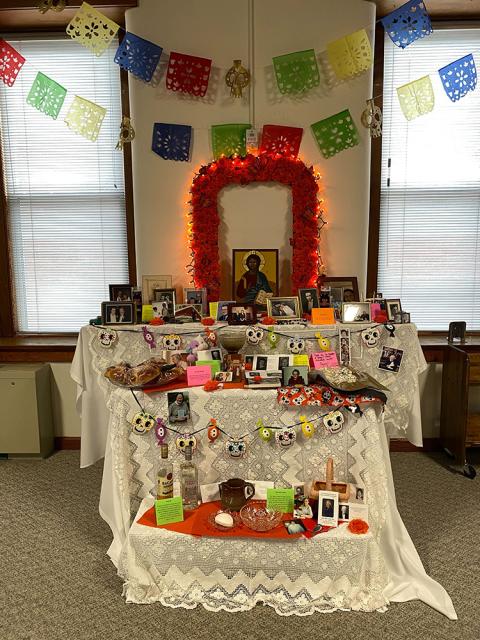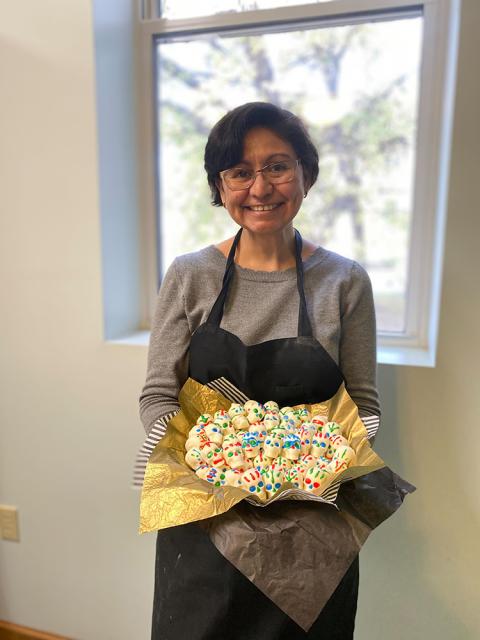
Two photographs displayed on the All Souls' Day altar at Mount St. Scholastica Monastery in Atchison, Kansas, commemorate people close to Sr. Helga Leija. The photo on the left shows her with her two grandmothers; the photo on the right is of her, on the left, and her vocation director and friend, Sister Rose Miriam. (Photo courtesy of Helga Leija.)
As I walk around our Benedictine monastery in Atchison, Kansas, and see our trees slowly changing their colors for fall, my heart takes me back to the Mexican markets of my youth, where the cempasúchil flowers and supplies are sold to prepare the altars for the Day of the Dead. This celebration begins in Mexico on Oct. 28 and culminates with festivities on Nov. 2.
Celebrating and honoring those who have died is a basic part of my Mexican DNA. Although I am not in Mexico, I do my best each year to honor this part of my culture and religious tradition that has been handed down to us from pre-Hispanic times.

The 2022 Dia de Los Muertos altar at Mount St. Scholastica Monastery in Atchison, Kansas, displays photographs of loved ones of sisters who have passed away, as well as other items to remember them by. (Photo courtesy of Helga Leija).
The ancient Aztec society believed that life continued beyond death, so when people died, they were wrapped and buried, and their relatives organized an elaborate celebration in order to guide them on their way to Mictlán, the kingdom of the dead. The journey there was long, dark, difficult, and filled with many obstacles and dangers.
The souls could only arrive at Mictlán with the help of a Xoloitzcuintle, a hairless dog breed believed to be a holy guardian, who would only help them if they had been kind to animals during their lifetime. The family would also place food that their deceased loved ones liked on their altars at home to provide sustenance during their journey.
When the Spaniards arrived in Mexico, bringing Catholicism with them, the celebrations did not disappear, but instead were adapted to what has become a beautiful example of syncretism during All Souls' Day and All Saints' Day. Today in Mexico, contemporary observance of Day of the Dead includes Masses and devotional prayers such as novenas and rosaries as well as visits to the graves of families and friends on Nov. 1 and 2.
These November days coincide with the arrival of the monarch butterflies to Mexico. For many people in Mexico, especially in the southern state of Michoacán, the monarch butterfly is a sign that announces that the Day of the Dead is near. When those of us who grew up in the northern part of the country see the migration of butterflies at the beginning of October, we have more time to prepare for the visit of our dearly departed ones. The ancient Purépechas, an Indigenous group from Michoacán, believed that the monarch butterflies contained the souls of the dead and that on Nov. 1 and 2, the souls of the dead traveled on the wings of the monarch butterflies to visit the altars their families prepared for them.
Advertisement

Sr. Helga Leija poses with sugar skulls for the Day of the Dead celebration at Mount St. Scholastica Monastery in Atchison, Kansas (Photo courtesy of Helga Leija).
What is offered on the altar is traditional, cultural and deeply personal to each family. With each offering, we honor the memory of those we love. We decorate the altars with bright flowers, and we cook the foods they liked. We bring out their favorite items and also place on the altar their picture, candles, flowers and other religious items. We gather as a family after Mass to pray the rosary, sing and celebrate life together. We still believe, like our ancestors, that during these days, the strength of our love and remembrance grants the souls of our loved ones a temporary return home to the world of the living. They celebrate with their families when they come home, and they are nourished by the essence of the food offered to them as well as by being with their loved ones and celebrating both life and death. At this time, we honor and thank them for their lives and for going before us to make our journey easier.
These days are happy occasions, celebrations of life, filled with storytelling and sharing life with the rest of the family. One would imagine sadness at remembering that those we love are no longer here, but there is prayer, food, music and laughter. Why should we be sad? After all, as George Eliot said, "Our dead are never dead to us until we have forgotten them." If we keep honoring their memories, lighting candles for their souls, and celebrating yearly with them, their memory will triumph over oblivion.







